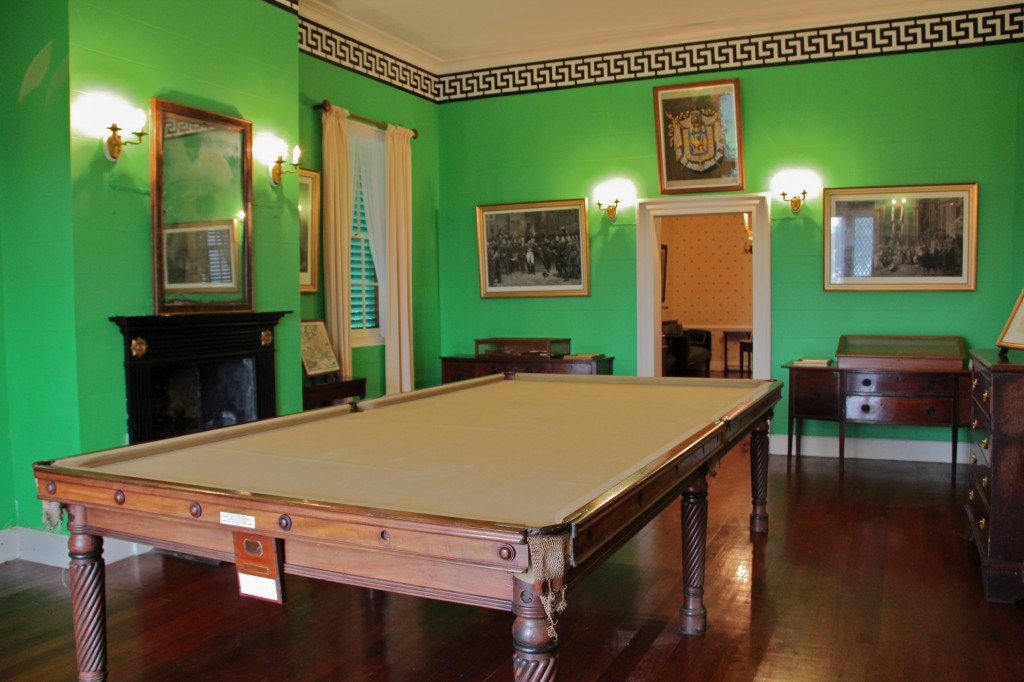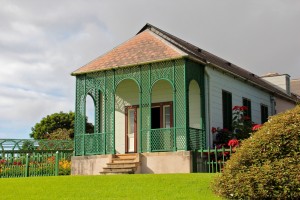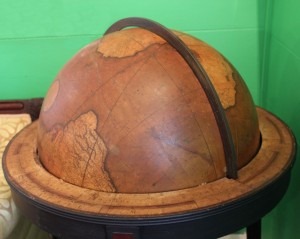 As visitors did during Napoleon’s time, I entered Longwood House up the stone steps through the green latticed portico, and stepped into the Billiard Room. The French volunteers-in-exile who had accompanied Napoleon crossed that same threshold with heavy hearts for a man without a future. Back then, sympathizers and enemies alike must have felt awe seeing the face of the Emperor. For almost two hundred years, countless pilgrims, scholars and the curious have journeyed to this remote spot—all for a chance to experience his fallen glory.
As visitors did during Napoleon’s time, I entered Longwood House up the stone steps through the green latticed portico, and stepped into the Billiard Room. The French volunteers-in-exile who had accompanied Napoleon crossed that same threshold with heavy hearts for a man without a future. Back then, sympathizers and enemies alike must have felt awe seeing the face of the Emperor. For almost two hundred years, countless pilgrims, scholars and the curious have journeyed to this remote spot—all for a chance to experience his fallen glory.
 I had approached those steps warily, afraid of disappointment. I’m not a groupie or celebrity chaser. I’m just a writer looking for the atmospherics and inspiration that lead to something called Voice. Or Truth.
I had approached those steps warily, afraid of disappointment. I’m not a groupie or celebrity chaser. I’m just a writer looking for the atmospherics and inspiration that lead to something called Voice. Or Truth.
Still, the stone steps gave me pause. Those stones are authentic, a place where Napoleon had stood, contemplating his exile. The rest of the physical structure felt less intimidating, having been replaced bit by bit as it disintegrated over the years, although the portico, with its green lattice work, was eerily familiar from old drawings I’d seen.
 I took a deep breath in the Billiard Room. At first, the green walls were a shock, but they are a faithful reproduction, as is the black and white geometric frieze. The billiard table is the original, and so are two large globes, one terrestrial, the other celestial. Napoleon’s entourage preferred this room to all the others because it had the most light. I could almost see them gathered around the table, but they rarely got to play. Napoleon didn’t like billiards and, as he had in Malmaison’s billiard room, he spread his maps across the table’s surface. There, as an up-and-coming general, he formulated a future; here as a prisoner, he rehashed the past.
I took a deep breath in the Billiard Room. At first, the green walls were a shock, but they are a faithful reproduction, as is the black and white geometric frieze. The billiard table is the original, and so are two large globes, one terrestrial, the other celestial. Napoleon’s entourage preferred this room to all the others because it had the most light. I could almost see them gathered around the table, but they rarely got to play. Napoleon didn’t like billiards and, as he had in Malmaison’s billiard room, he spread his maps across the table’s surface. There, as an up-and-coming general, he formulated a future; here as a prisoner, he rehashed the past.
Most people call this the Billiard Room. Napoleon called it his Topographical Cabinet. Writers or emperors, we all recreate the world with our unique vision and think it’s the truth.

Margaret, what a cool trip you’re on! Is your view of Napoleon changing the more you see, or are your thoughts being confirmed?
Love the photos, especially the daisies and Jacob’s Ladder (yikes!).
I would say that my knowledge has deepened rather than changed, but I’m still mentally processing all I have seen. I probably won’t know the answer until I get writing.
Those green walls are startling. Are they not the same green walls referred to as the source of poisoning that gradually killed Napoleon?
But why none of his companions? From the exterior entrance it is obvious why Green. It was his Imperial color.
I have been trying to locate a book about Longwood that I read earlier in the last decade and I seem to recall it was titled,The Black Book; rather than the Dark Book. It was a rather small book and a fast read about life at Longwood, Ste.Helena. I live quite close to Pennsylvania’s Longwood, home of Pierre du Pont, and when I originally arrived to live on a farm could get there within a half-hour drive that brought me to the back-entrance of the estate that takes you past the greenhouses.(this was convenient for my neighbours who went there to work each day) I will in fact, as I usually do, go there for Thanksgiving dinner, about two weeks from now; mostly out of habit because I always discover something more each time I am there. My mother’s grandmother was born here in Pennsylvania, exact place unknown, when her parents arrived from France at a period when Napoleon and all to do with him had fallen into disfavor.
Hi, Dianne,
The billiard room’s green walls are truly startling. They are supposed to be the authentic “empire green” that Josephine had popularized. Although I’m not an expert on (or even a fan of) the poisoning theories, I’ve read that in Napoleon’s time many green dyes contained arsenic, which tended to leach into the air. There was also green in some of the wallpaper. One of his companions, Cipriani (the Maître de Hôtel) did die suddenly in 1818, perhaps of poisoning. Maybe Napoleon could have been affected more than others because he rarely left the building during his last two years.
The book you are looking for is The Black Room at Longwood, by Jean-Paul Kaufmann. It’s excellent! And I agree that Longwood in Pennsylvania is a treat, especially around the holidays.
Take care and thanks for your comments!
Margaret
Hello, Dianne,
When you commented recently, you mentioned that your mother’s grandmother had been born in Pennsylvania. Was her family name Jarreau like yours? There was a mysterious Mme and Mlle Auziere who lived in Elwood, NJ, (not far from PA) at the turn of the century and had The Manuscript of St Helena, a document which Napoleon may or may not have dictated.
Just curious.
Margaret
Margaret,
Could I have your permission to use your photograph of the Billiard Room at Longwood House.
It shows the two Thurston (biliiard company) plates that we have pictures of in our collection. (see https://www.snookerheritage.co.uk/histories-articles/thurston-co/) which has a picture of the letter from The letter from ‘La Societe des Amis de St. Helena. (it sufferd some damage in 1940).
I want to put a short article together with regard to the Thurston company supplying the table and al;so the references we have in a a sales ledger dated 1819 to supplying cues etc. to British troops guarding Napoleon
Yes, Peter, please go ahead and use the photos with attribution and if possible a link to this site. I was very fortunate to be able to spend time in that room alone and to take photos. The table is a beautiful piece. Send me the article when it comes out, please!
All the best,
Margaret
I have a modest collection of souvenirs and artwork relating to Napoleon. I have been wanting to paint my hallway where much of the Napoleon items are displayed, and ran across this brilliant green from Longwood. I wrote to the French Consul in charge of Longwood, Michel Dancoisne-Martineau about the color, he said it is Vert-de-Paris, sometimes called Georgian Green. The colors I have found thus far which are called Georgian Green are not nearly this brilliant.
The vert paint pigment is made from scrapings off copper which has been treated with vinegar, which produces the bright green verdigris color.
I believe arsenic is used in inks for wallpaper and some fabrics, rather than paint.
Yes, David, arsenic in Longwood’s green paint and wall paper is one theory about Napoleon’s death by poison. Then people ask, why didn’t everyone else die? The answer given is that Napoleon spent his last two years inside Longwood House, continually breathing its air, rarely going outside–all to spite Hudson Lowe, the British governor. We’ll probably never know. The French aren’t going to exhume his body for analysis and even if they did and found arsenic, I doubt we’d know its source. Thanks for your comment. When you get the display done, send me a photo!
Margaret
Pingback: How was Napoleon as a billiards player? - Shannon Selin